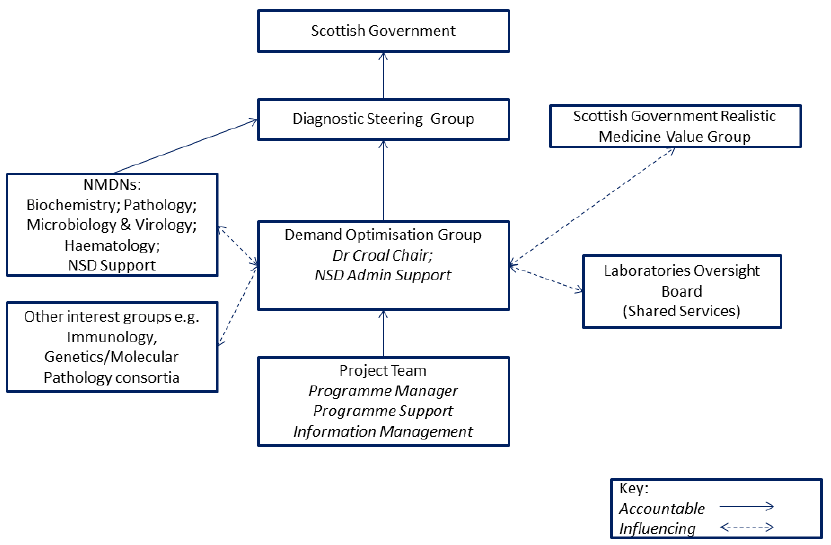Demand optimisation in laboratory medicine: phase two report
Phase two activity report produced by the Scottish National Demand Optimisation Group (NDOG).
3 Introduction
3.1 Background
It has been widely accepted that there is considerable variation in the use of diagnostic tests across the NHS. While some of this variation can be explained by clinical circumstances and demographic differences, some of the variation may be attributed to inappropriate test requesting by clinicians as a result of over/under-requesting and unnecessary repeat testing. In addition, lack of availability or awareness of certain tests across the NHS Boards may also limit their optimal use.
Demand Optimisation is defined as the process by which diagnostic test use is optimised to maximise appropriate testing, which in turn optimises clinical care and drives more efficient use of associated scarce NHS resources.
In order to target demand optimisation, the key areas to consider are:
- Minimising over-requesting and under-requesting, both of which can be damaging to patient care
- Reducing unnecessary repeat requesting
- Ensuring appropriate and useful test repertoires are universally available across all healthcare outlets
- Standardisation of nomenclature/test coding to reduce unnecessary variation and allow automated data monitoring systems to extract laboratory test usage information in an efficient, consistent and timely manner
- Internal standardisation of laboratory practice – to ensure the optimal processes, procedures and testing protocols are adhered to.
It is important to acknowledge that the optimisation of rational diagnostic testing may not only bring about more efficient use of resources within diagnostics but it is the knock-on effect for patient care pathways that will ultimately be more valuable. However, it is also vital to recognise that diagnostics and pathways interact in complex ways which may not be immediately evident to laboratories. There may
be examples that certain, seemingly inappropriate, diagnostic tests are requested,
to ensure the patient is admitted to the correct pathway and receive the
appropriate care.
Demand Optimisation interest has been rising for many years and it has become a focus programme within the Scottish Government’s Healthcare Science National Delivery Plan (NDP). In 2015, the Scottish Government requested that a National Demand Optimisation Group (NDOG) be established to review the third deliverable of the NDP, which states:
NHS board healthcare science leads will work with stakeholders to develop local improvement plans to reduce unnecessary testing across primary and secondary care. This will free-up capacity to address rising demand and deliver testing that positively affects the patient pathway, supports primary care preventive measures and reduces hospital referrals and admissions.
The first phase of Demand Optimisation began in 2015 in order to review existing demand optimisation work, to deliver an improvement plan to optimise diagnostic testing for patients and to support the implementation of the National Clinical Strategy and Scottish Government’s Healthcare Science National Delivery Plan.
In January 2017, the group produced an extensive report, detailing a comprehensive overview of demand optimisation and demand management activity and structures across NHS Scotland.
Following publication, diagnostic networks reformed their demand optimisation subgroups or directed their Steering Groups to progress implementation of the report and local arrangements were put in place in some NHS Board areas. However, there was no over-arching, cohesive national plan to progress the recommendations of the report.
The Diagnostic Steering Group identified the need to support implementation of the report recommendations and the second phase of Demand Optimisation began in February 2018.
3.2 Group Membership
The multidisciplinary National Demand Optimisation Group (NDOG) was formed in 2015, with minor representation changes for phase II, and has been developing a number of aims and workstreams around demand optimisation. The group had representation from Scottish Government, National Services Scotland and the National Managed Diagnostic Networks, as well as representation from laboratories including Biochemistry, Microbiology / Virology, Pathology, Haematology and Clinical Immunology. There was also representation from the Genetics / Molecular Pathology consortia and the Scottish National Blood Transfusion Service. Full details of the group membership can be found in Appendix A.
The group representatives cascaded work through established formal and informal networks to lab users. In addition, engagement with service users was sought throughout the development of the Atlas of Variation. This provided the opportunity for reciprocal interaction to drive forward improvement and ensure a whole systems focus.
3.3 Governance of the NDOG
The Scottish Government Healthcare Science Officer commissioned the work, Scottish labs teams provided the expertise and NSS provided the resource and methodology to ensure improvements could be replicated and sustained.
The governance structure employed in the work was: -
Figure 1: NDOG Governance structure

A website provided additional information and regular bulletins were issued to highlight the work of the NDOG.
Contact
Email: CNOD_Admin@gov.scot
There is a problem
Thanks for your feedback